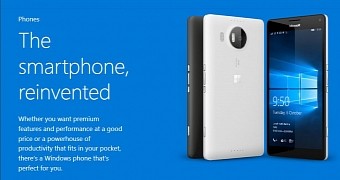Windows 10 Mobile is just around the corner and it's not a secret that Microsoft's betting big on this release, offering it completely free of charge to absolutely all devices running Windows Phone, no matter the screen size, storage capacity, or RAM.
As a result, Redmond is getting ready for the transition off Windows Phone with a new important change: the WindowsPhone.com website has been retired, with the link now redirecting users to the official Windows phones page.
The change might not seem significant at the first glance, but it's a major step towards the rebranding process that Microsoft is about to embark on for its smartphone strategy. There's almost no mention of Windows Phone on this new page, and just like WMPU noticed, the focus is on Windows 10 Mobile and the new devices that Microsoft presented at its hardware event on October 6.
Windows phones, not Windows Phone
Instead of Windows Phone, Microsoft's now talking about Windows phones, which is part of its strategy to show everyone that Windows is now powering all their devices, with features introduced specifically to unify the platforms and bring them together.
The store, for instance, is now the one destination for apps on Windows 10, be they for PCs or smartphones, and it not only comes with a similar UI and feature lineup but it also provides access to universal apps designed to run on any screen size.
Microsoft itself has developed a bunch of universal apps, including the Edge browser, which is the best example of how such a program should work. The tool is available on both PCs and smartphones and can adapt to different screen sizes, while also offering the same features on all devices.
Obviously, the biggest challenge is to convince all developers to do the same thing and code for Windows 10, but time will tell if the opportunity is appealing enough to help Microsoft succeed with this plan.
Update: As @mikimaus7080 pointed out, Nokia is no longer in the device list, so Microsoft's indeed putting the focus exclusively on its own and partners' devices.

 14 DAY TRIAL //
14 DAY TRIAL //